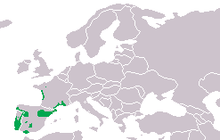Knife foot
| Knife foot | ||||||||||||
|---|---|---|---|---|---|---|---|---|---|---|---|---|

Knife foot ( Pelobates cultripes ) |
||||||||||||
| Systematics | ||||||||||||
|
||||||||||||
| Scientific name | ||||||||||||
| Pelobates cultripes | ||||||||||||
| ( Cuvier , 1829) |
The knife foot ( Pelobates cultripes ) is a close relative of the common spadefoot toad ( Pelobates ) as a representative of the European sea toad . While this is a type that is particularly widespread in Central and Eastern Europe, the knife foot takes its "place" in southwestern Europe.
features
The males rarely grow larger than seven centimeters (head-trunk length); the females are somewhat stronger. In contrast to the common garlic toad, the relatively large, short-nosed head is not arched like a helmet behind the eyes. Ear glands ( parotids ), as in the real toads , are not pronounced. As in all toad frogs, the strongly protruding eyes have a vertically slit pupil; the iris is colored green-silvery. In the case of the rather short rear limbs, the inner heel hump on the soles of the feet, which has been converted into a sharp-edged "digging shovel", is particularly noticeable, which is black in this species (in the common garlic toad: light brown). The relatively smooth skin, which is warty at most on the flanks, is variably colored on the upper side: on a whitish, yellow-brown or gray base tone there are irregular spots that can be green, gray or dark brown. The belly and throat are white like the common garlic toad, often with “washed out” gray spots. As with their Central / Eastern European relatives, the males have thickened humerus glands, especially during the mating season.
Habitat, way of life, distribution
The knife foot populates open landscapes with light (sandy) soils, into which it can dig itself backwards very quickly with its grave calluses. This includes coastal dunes as well as agricultural landscapes. Plain to gently undulating areas are preferred to mountainous regions rich in relief (only exceptionally occurrences up to 1400 m above sea level in Spain). During the day the animals hide in self-dug holes 6 to 20 centimeters deep; at night - especially in rainy weather - they hunt for insects and their larvae. Their predators include snakes, herons and owls; the tadpoles follow the newts and water beetles or swimming beetles. In the north of the distribution area the knife foot probably hibernates for a short time ; in the south, on the other hand, a drought- related summer rest .
The distribution area of the species is concentrated on the Iberian Peninsula with Spain and Portugal; it is also found in the French Mediterranean region. In France there is also a disjoint subarea on the western Atlantic coast between St. Nazaire and Bordeaux . An occurrence listed in the literature in the Spanish exclave of Melilla, which is surrounded by Morocco, is doubtful and can possibly be assigned to the Moroccan knife foot .
Reproduction

The breeding season is very different depending on the region: in Andalusia or southern Portugal from October to February, in northwestern Spain from around February to the end of April. Usually after heavy rains the nightly migration of the knife feet to the spawning waters begins . As such, temporary water-carrying pools , weedy ponds and sometimes slow-flowing streams sought; slightly salty brackish water is not avoided. The numerically predominant males arriving first stay at the water for only one night, but return there several times during the spawning season. As mating calls, they produce - again similar to the common garlic toad - quiet, monotonous series of calls under water ("ko..ko..ko"), which sound like the chuckling of a hen. The females, who stay a little longer at the spawning site and can only spawn once a year, respond to the calls with similar vocalizations.
When mating, the male does not clutching his strong front legs, the female axillary, but in the lumbar region ( inguinal Amplexus ) as the "Low" and "Middle" Anura ( submissions Archaeobatrachia and mesobatrachia ; see toads , midwife toads , Disc- , Mud divers , clawed frogs ) is typical. Finally, the female deposits a short, 12 to 20 millimeter thick spawning cord in which the gray-brown eggs are arranged irregularly and in multiple rows in jelly shells. The larvae need four to six months to metamorphose into land animals; beforehand, they reach considerable dimensions with lengths of up to twelve centimeters. The freshly metamorphosed young animals are still two to three centimeters tall after resorption of the oar tail.
Hazard and protection
The habitats of the knife feet are impaired by tourism (dune landscapes!), Afforestation and agricultural intensification. In the course of global climate changes , increased periods of heat and drought must also be expected in south-western Europe, which, among other things, could threaten the spawning waters.
Legal protection status
- Fauna-Flora-Habitat Directive (FFH-RL): Annex IV (species to be strictly protected)
- Federal Nature Conservation Act (BNatSchG): strictly protected
literature
- Andreas Nöllert & Christel Nöllert: The amphibians of Europe. Franckh-Kosmos, Stuttgart 1992, ISBN 3-440-06340-2
Web links
- Photos of the knife base on www.herp.it
- Pelobates cultripes inthe IUCN 2013 Red List of Threatened Species . Posted by: Pedro Beja, Jaime Bosch, Miguel Tejedo, Miguel Lizana, Iñigo Martínez-Solano, Alfredo Salvador, Mario García-París, Ernesto Recuero Gil, Valentin Pérez-Mellado, Carmen Diaz Paniagua, Marc Cheylan, Rafael Marquez, Philippe Geniez, 2008. Retrieved November 20, 2013.



